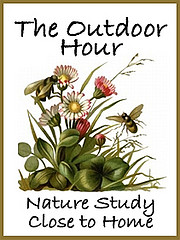 Hi, I'm Heidi and I homeschool my two sweet kids. I want them to know that learning is an exciting lifelong adventure! We love great books, unit studies, notebooking, lapbooking, and hands-on learning.
Hi, I'm Heidi and I homeschool my two sweet kids. I want them to know that learning is an exciting lifelong adventure! We love great books, unit studies, notebooking, lapbooking, and hands-on learning.50 States Unit Study: Nature Study
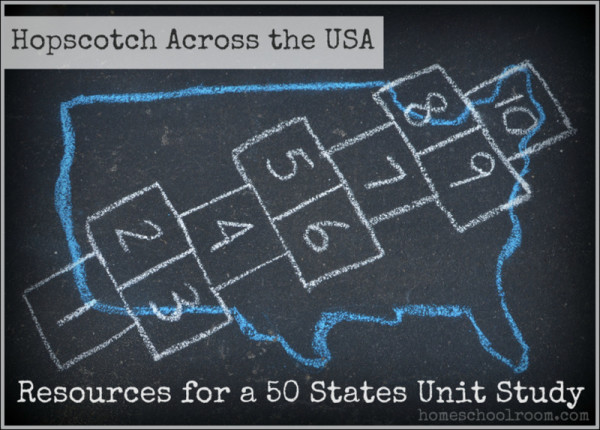
Welcome to day 8 of Hopscotching Across the USA! I’m sharing resources for a 50 States Unit Study and today I’m talking about nature study.
Nature study is a regular part of our school schedule as Charlotte Mason-inspired homeschoolers. Though nature study usually involves direct observation of items in your local environment, in our 50 states study it was about studying nature in other parts of our country. Being in the far northeast is was fascinating to learn about the environment and living things in different states.
America’s physical diversity ranges from mountain to prairie, deserts to tundra. Some areas have long cold winters while others stay humid and tropical. If you have a U.S. Atlas you can introduce your children to this diversity with the maps that show physical or environmental features. Education Place’s free printable maps for the climate (average temperature and annual precipitation) and physical features (major mountains and rivers) are great for adding to their binder to refer to as you study each state.
*This post contains affiliate links.
Animals of America
We didn’t focus on remembering which 7 states chose the cardinal as their state bird, but we did learn about some of the different animals that call the United States home. When there was a new-to-us animal (like the bison of the prairie or the alligators of the Southeast or the armadillo of Texas) that we wanted to learn about two sites were valuable, easy resources:
- For birds you can’t beat Cornell’s All About Birds website. Search for any bird in the United States and you can find out all about it’s lifestyle, where it lives, and enjoy images, sound clips, and often videos.
- For animals we can usually find it on National Geographic Kids. You can find general information about the animal, a distribution map, along with photos and often sound clips or videos.
United Tweets of America is a comical educational book worth adding to your bookshelf. The story line is that the birds from each state are competing in a pageant. You won’t find the standard basic statistics about each state, but it is filled with interesting information and anecdotes.
Plants of America
When it comes to plants I wasn’t attempting to teach my children about all the plants in our country. The atlas has photos of the state flowers, and 50states.com has photos and information for the state flowers and trees. There were a few interesting stories and books about some famous trees of the 50 States:
- The Palmetto Tree of South Carolina (it’s the state tree, part of the nickname, and is on the flag) has an interesting story: during the Revolutionary War a fort built from the Palmetto absorbed cannon shot due to its spongy wood, helping protect Charleston Harbor from the British.
- Incredibly strong Live Oak was used with White Oak to build the U.S.S. Constitution, and earned her the nickname “Old Ironsides.”
- These three books about trees are some of our favorites–they aren’t dry science books about identifying trees, but highlight the importance of trees in our country and the history that trees live through with us:
- Arbor Day Square is a book about trees on the wide open prairie–and the beginning of Arbor Day.
- The Tree That Would Not Die tells the story of the 500 year old Treaty Oak tree in Texas, (a southern live oak like those used in Old Ironsides) relating a lot of history along the way. I’ll admit getting teary reading the part about the poisoning of the tree.
- Tree in the Trail by Holling C. Holling is about a cottonwood tree on the great plains, relating the history of the native people, white settlers, and the Santa Fe Trail.
Natural hazards
The topic of natural hazards fascinated my children, especially my son, probably because in Maine our only natural hazards are blizzards and ice storms. Sometimes we get the tail end of a hurricane but usually with very little impact. Not that I’m complaining, but it was a subject that many other Americans have a greater working knowledge of due to suffering the effects closer to home.
- Earthquakes: we read two books about Earthquakes: Earthquakes (Let’s Read and Find Out Science) by Franklyn M. Branley and Earthquakes by Seymour Simon.
- Volcanoes: National Geographic Kids: Volcanoes! shows the ring of fire and features created by volcanoes like Crater Lake in Oregon, Hawaii, and the geysers of Yellowstone. We learned about the 1980 eruption of Mt. St. Helens in this fascinating and educational YouTube video from geologists who had been watching the volcano for two months, and this video from the Forest Service is newer and gives an update on the area now.
- Tornadoes: the power of tornadoes was clear in a Nova show: Hunt for the Supertwister, which is available to watch from PBS on YouTube.
Come back tomorrow for a critical part of a 50 states study: learning about the people of the United States. Subscribe via email or RSS so you don’t miss a post!
Here are the topics from this series:
Day 1: Introduction to the 50 States Unit Study
Day 2: Learning About the States
Day 3: Getting to Know Your Geography
Day 4: Games to Play
Day 5: Recording Your Journey
Day 6: Famous Places in the USA
Day 7: Natural Attractions
Day 8: Nature Study
Day 9: The People of America
Day 10: Food from the 50 States
I’m teaming up with over 25 other iHomeschool Network bloggers. Hop over to iHN for ideas from veteran homeschooling moms on topics ranging from Teaching with Legos to Project Based Learning.
50 States Unit Study: Natural Attractions

Welcome to Day 7 of 10 Days of Hopscotching Across the USA! Yesterday I shared the man-made attractions that make me want to jump in an RV for a road trip–today I’m sharing all about the wonders of nature that are worth visiting!
As the third largest country in the world, spanning a continent from ocean to ocean and including among our states Alaska and Hawaii, our country is rich with natural features worth highlighting.
*This post contains affiliate links.
These two books share an appreciation for the general beauty of the United States:
- Across America, I Love You by Christine Loomis is a unique book that draws parallels between the beauty of the varied landscape of America and a mother’s love for her child.
- America the Beautiful This beautiful book pairs the words to the Katharine Lee Bates song with the illustrations of her great great grandnephew Chris Gall. She wrote her first draft of the words when she was at Pike’s Peak, which is why I’m listing this book in this post. I loved the choices for illustrations, many depicting America’s natural beauty, but others showcasing the human aspects of our country (like Ground Zero). Though it is easily enjoyed by young children I was touched by it as a not-so-young person.
National Parks
One of the obvious natural features to highlight are the national parks, which we enjoyed learning about with books and videos.
These videos from National Geographic were available on Netflix, and some can also be streamed from the National Geographic website.
American Wonders:National Parks of the West shared an inside look at the Grand Tetons of Yellowstone, Waterfalls of Yosemite, and the Grand Canyon. We also read the book Wonders of America: The Grand Canyon.
American Serengeti: America’s Great Plains This is not about a current national park, but about efforts to rebuild the prairie and restore its wildlife.
Physical Features
There are many notable physical features and unusual natural features you can point out as you move through the fifty states. This isn’t an exhaustive list, but are some of the places that intrigued us.
- Rocky Mountains: we read Wonders of America: The Rocky Mountains
- Appalachian Mountains
- Mississippi river
- The Great Lakes (Bordering states in the Midwest and Northeast, Michigan borders four of the five lakes)
- Great Salt Lake (Utah)
- Crater Lake (Crater Lake National Park, Oregon)
- Old Faithful: (Yellowstone National Park, Wyoming) At the National Park service website they have a webcam. Scroll down for many educational links about geysers.
- Old Man of the Mountain (New Hampshire) The famous profile collapsed in 2003, a group is working to create a memorial.
- Niagara Falls (New York)
- Devil’s Tower (Wyoming)
- Chimney Rock (Nebraska)
- Mt. McKinley (Alaska) is the highest mountain peak in the U.S.
- Mount Washington (New Hampshire) We drove up the auto road once, and it scared me half to death!
Come back tomorrow for ideas for nature study to go along with your 50 states study. Subscribe via email or RSS so you don’t miss a post!
Here are the topics from this series:
Day 1: Introduction to the 50 States Unit Study
Day 2: Learning About the States
Day 3: Getting to Know Your Geography
Day 4: Games to Play
Day 5: Recording Your Journey
Day 6: Famous Places in the USA
Day 7: Natural Attractions
Day 8: Nature Study
Day 9: The People of America
Day 10: Food from the 50 States
I’m teaming up with over 25 other iHomeschool Network bloggers. Hop over to iHN for ideas from veteran homeschooling moms on topics ranging from Teaching with Legos to Project Based Learning.
50 States Unit Study: Famous Places in the U.S.A.

Welcome to Day 6 of 10 Days of Hopscotching Across the USA! There are so many famous places and things I’d love to see on a tour of the 50 states. Today I’ll be sharing about the man-made structures that attract tourists within our country (come back tomorrow for the natural wonders).
* This post contains affiliate links.
You’ll come across many famous places as you study the 50 states, and it’s up to you which ones you spend more time researching! Before I share our list of favorites, I’ll tell you where I usually looked for more information on the sites that piqued our interest.
- Library: Library searches led us to go-along books for some of the most interesting sites.
- Netflix: Our subscription to Netflix pays off time and again as we find educational videos related to our schoolwork. Series shows like Modern Marvels, American Experience, and Ken Burns America all have specials on various landmarks.
- At The History Channel Website you can search by topic to see links to related short videos. You can also browse all videos in the topics The States or Deconstructing History to find short clips on many sites from the Alamo to the Pentagon to Ellis Island.
These were our favorite man-made attractions, and for most of them the story behind why and how they were built was part of what intrigued us:
Statue of Liberty (we read The Magic School Bus Builds the Statue of Liberty and Ken Burns’ America: The Statue of Liberty)
Empire State Building (we watched Modern Marvels: Empire State Building)
Gateway Arch in Missouri: The story behind this monument is great historical information to teach your children: the Gateway Arch website shares the history and interesting facts.
Golden Gate Bridge (we watched Modern Marvels: Golden Gate Bridge) California
Erie Canal: we enjoyed the book The Amazing, Impossible Erie Canal by Cheryl Harness
Mount Rushmore South Dakota: We read Wonders of America: Mount Rushmore and watched Modern Marvels: Mount Rushmore.
Hoover Dam Nevada: This amazing undertaking built during the Great Depression is a fascinating story. There are short videos worth your time on the History Channel website. We watched the full Modern Marvels: Hoover Dam.
The White House: The book The Story of the White House by Kate Waters was filled with interesting pictures of all the famous rooms, the private family areas, and the special events and changes throughout history. The National Geographic program Inside the White House was terrific and really reminded us that not only is it a landmark for America but a home for the president’s family. The professional work done by all the staff really impressed me.
Lastly, don’t forget to have a little fun! We watched a comical show called A Program About Unusual Buildings and Other Roadside Stuff that did make us want to hit the road to see the giant ketchup bottle, house shaped like a shoe and other crazy things people have built!
Come back tomorrow for the natural features of the 50 states! Subscribe via email or RSS so you don’t miss a post!
Here are the topics from this series:
Day 1: Introduction to the 50 States Unit Study
Day 2: Learning About the States
Day 3: Getting to Know Your Geography
Day 4: Games to Play
Day 5: Recording Your Journey
Day 6: Famous Places in the USA
Day 7: Natural Attractions
Day 8: Nature Study
Day 9: The People of America
Day 10: Food from the 50 States
I’m teaming up with over 25 other iHomeschool Network bloggers. Hop over to iHN for ideas from veteran homeschooling moms on topics ranging from Teaching with Legos to Project Based Learning.
50 States Unit Study: Recording Your Journey

Welcome to Day 5 of 10 Days of Hopscotching Across the USA! Today I’m sharing ways to record all the information you’ll be learning during your study of the 50 states.
Your children can create a notebook of their 50 states study that is a tool for later reference as well as a treasured memento. My children still enjoy looking through theirs. We started with a sturdy binder and added dividers for each region of the United States, then simply added to it as we worked through the fifty states.
Maps
Of course a geography-based unit study notebook needs maps, and here are two options I found for great free printable maps:
- Education Place has free printable maps for each state and Washington, DC. They also have maps of the different regions of the United States with and without labels. In addition to coloring in the outline map of the state, I would recommend having your child also color each state on an outline maps of the United States to reinforce that state’s location within the U.S.
- You can find loads of free U.S. Geography resources on Homeschool Share. The “Where is…” printable are great because they show the outline of the individual state and a full map of the U.S. It is offered as a full size notebooking page and a minibook.
Notebooking
As you learn about each state your children can record the information using notebooking. (What is notebooking, you ask? Well, The Notebooking Fairy has a great definition on her home page.) From plain paper to more formal notebooking pages the options are endless!
- Our favorite ended up being a simple blank sheet of paper that my children made into a mini travel poster for each state. I got their creative juices flowing by telling them these three things to be on the lookout for to add to their poster: What is fascinating about the state? What is the state famous for? What is your favorite thing about the state?
- Another idea would be to use the outline maps as a notebook page–draw or write your information directly on the map.
- Homeschool Creations offers two options for free state notebooking pages, each with spaces for recording specific information.
- NotebookingPages.com sells two different bundles of state notebooking pages.
- Homeschool Share has minibooks for state symbols, flowers, birds, flags, and general trivia that could be added to your notebook.
One of the things I love about notebooking is how flexible it is! You can add as many pages for each state as you want. Other than a general page for each state, your children could create additional notebook items for anything they learned about that was interesting to them. For recording extra information like this I keep Jimmie’s free General Notebooking Pages set (scroll down to “General Printables”) in a binder and have my children choose one for their topic.
Here are some ideas for topics to notebook:
- the history of the flag design, state name, or motto
- a famous person, event, or place
- animals or plants found in the state
- recipes: I’ll be sharing about food from the 50 states next week, and recipes can be great to add to your binder.
- photos: Did your son build the Statue of Liberty out of Legos or pretend to be a cowboy when you studied Texas? Snap a picture and add it to your notebook.
- postcards would be a fun addition if you could join a postcard swap
I hope you’ll come back next week because I’ll be sharing ideas and resources for all the extra information you can dive into during your 50 States unit study! Subscribe via email or RSS so you don’t miss a post!
Here are the topics from this series:
Day 1: Introduction to the 50 States Unit Study
Day 2: Learning About the States
Day 3: Getting to Know Your Geography
Day 4: Games to Play
Day 5: Recording Your Journey
Day 6: Famous Places in the USA
Day 7: Natural Attractions
Day 8: Nature Study
Day 9: The People of America
Day 10: Food from the 50 States
I’m teaming up with over 25 other iHomeschool Network bloggers. Hop over to iHN for ideas from veteran homeschooling moms on topics ranging from Teaching with Legos to Project Based Learning.
50 States Unit Study: Games to Play

Welcome to the fourth day of 10 days of Hopscotching Across the USA! Today I’ll be sharing games to play to learn about the 50 states.
What child doesn’t love to play games? Games can be a great way to sneak in a lot of practice with the states and capitals, along with soaking in other information about the 50 states. We found a few wonderful games that packed a lot of learning into a lot of fun.
*This post contains affiliate links.
Stack the States App
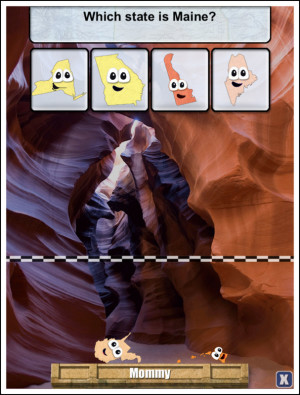
My kids loved Stack the States! Some of the questions are about facts we weren’t trying to memorize, but the game does continually reinforce the name and shape of the state along with the capital city. Steve wrote a detailed review of Stack the States on The Curriculum Choice.
Snapshots Across America Board Game
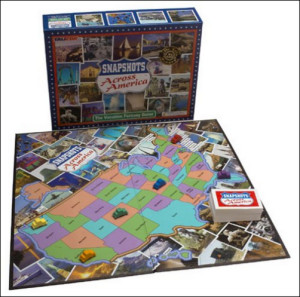
Snapshots Across America is our favorite board game about the US that not only reinforces the names and locations of the states but also famous sights, landmarks, and events. You can read my full review of Snapshots Across America on Curriculum Choice.
Scrambled States of America Board Game

The Scrambled States of America board game is based on the book I mentioned yesterday. At the start of the game the states are all mixed up from the party. Each player starts with five state cards that include the name, capital city, and nickname along with a cartoon drawing of the state.
The object is to send states “home” by matching them to the Scramble cards. Options on the Scramble cards include things like letters the state name or capital city starts with, touching a certain ocean or being closest to another state. Early readers need quite a bit of help with this game, but it is fun and involves frequent references of the state cards and map.
The only part I didn’t like about this game is that some Scramble cards ask for the state that is a certain color, wearing something, or showing teeth—there is no educational value since these are based on cartoon drawings.
Come back tomorrow for ways to record your journey of learning about the USA. Subscribe via email or RSS so you don’t miss a post!
Here are the topics from this series:
Day 1: Introduction to the 50 States Unit Study
Day 2: Learning About the States
Day 3: Getting to Know Your Geography
Day 4: Games to Play
Day 5: Recording Your Journey
Day 6: Famous Places in the USA
Day 7: Natural Attractions
Day 8: Nature Study
Day 9: The People of America
Day 10: Food from the 50 States
I’m teaming up with over 25 other iHomeschool Network bloggers. Hop over to iHN for ideas from veteran homeschooling moms on topics ranging from Teaching with Legos to Project Based Learning.
50 States Unit Study: Getting to Know Your Geography

Welcome to Day 3 of 10 days of Hopscotching Across the USA! Today I’m sharing ways to get to know the geography of the 50 States.
Throughout our study I wanted to continually work on the “big picture” of the United States. This was probably the one thing I did want my kids to memorize: the location of each state and it’s name and capital city.
*This post contains affiliate links.
Songs:
I bought the song Learning our Capitals by Twin Sisters Productions. It was a terrific 99 cent purchase! I played it frequently–while we were cleaning up, in the car…and we still listen occasionally. It’s an easy tune with a patriotic flare, and the words are easy to understand. (I can’t stand educational songs with unintelligible words or sung so fast you can’t really follow along!)
Books:
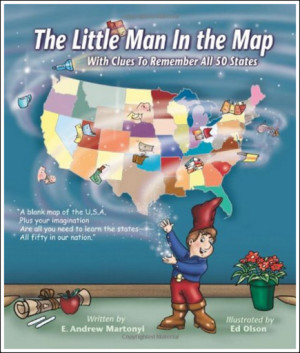
-
The Little Man in the Map: This is an incredibly creative book! It is about a classroom of children trying to learn the 50 states, so they turn the states into pictures with rhymes to remember their names. They identify a “man in the map” in the center of our country, and we still remember and describe Minnesota as “Mim’s hat” and remember other states based on their pictures in Man in the Map.
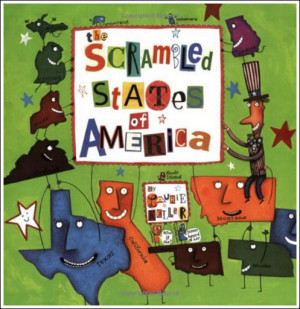
-
Scrambled States of America: we have the book and also the Scholastic Video (which is hilarious and well done). My son especially loved this silly book that reinforces each state’s name, shape, and location and some of what makes it unique (like food products or weather). In the book the states throw a party to get acquainted and decide to change places—unhappiness follows and everyone ends up back where they belong. My favorite part of the book are the illustrations–tiny details and funny dialog fills each page!
Puzzles:
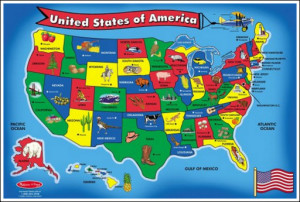
We utilized a couple different USA puzzles. I used a small one from the dollar store to take with us on the go. My favorite puzzle, though, was a large USA floor puzzle. The pieces are in the shapes of the states and the large size is beneficial so all but the tiniest New England state is its own piece.
Come back tomorrow for the games that helped us have fun and learn a lot during our 50 states study. Subscribe via email or RSS so you don’t miss a post!
Here are the topics from this series:
Day 1: Introduction to the 50 States Unit Study
Day 2: Learning About the States
Day 3: Getting to Know Your Geography
Day 4: Games to Play
Day 5: Recording Your Journey
Day 6: Famous Places in the USA
Day 7: Natural Attractions
Day 8: Nature Study
Day 9: The People of America
Day 10: Food from the 50 States
I’m teaming up with over 25 other iHomeschool Network bloggers. Hop over to iHN for ideas from veteran homeschooling moms on topics ranging from Teaching with Legos to Project Based Learning.
50 States Unit Study: Learning about the States

Welcome to the second day of Hopscotching Across the USA! Today I’m sharing how we learned about each of the 50 States. We had a routine we followed for each state, and then branched off on rabbit trails or activities based on our schedule and what piqued our interest.
*This post contains affiliate links.
First Steps for Information about the 50 States
Step #1: Atlas
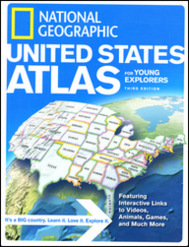
The first resource I’d recommend adding to your bookshelf is a nice atlas. We used the National Geographic United States Atlas for Young Explorers. There is an introduction to each region, a two-page spread for each state, and a companion website with videos, sound clips, and downloadable photos and maps.
For each state the text shares information about the basic stats, history, and major features along with several images for each state. The map is a full page with major cities, landmarks, physical features and economy symbols.
Step #2: Video
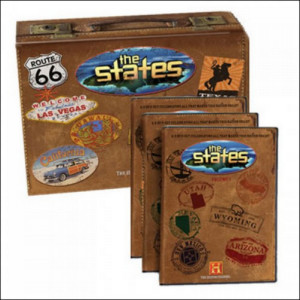
A DVD series I was glad I invested in was The States from The History Channel. After looking over the pages in the atlas we would watch the roughly 10 minutes video segment for the state. The information in the videos is quite varied: famous landmarks or events, famous people, geographic features, historical events…but they always gave us an interesting look into the state, and often led to topics we wanted to research further.
Please note that this series is for adults. With my 6 and 9 year old there was one state with a topic I chose to fast forward through, so you should preview before sharing with your children.
Step #3: State Quarters
A third major component of our study was the 50 States quarter collection. At the U.S. Mint website you can find printable images of the quarters (handy if you don’t have the actual quarters) and free lesson plans listed by issue year. I only used the download called “Additional Resources” that gives the background for the image on the quarter. (Note: The Additional Resources link near the bottom of the website that is supposed to cover all issue years is missing the 2008 quarters.)
You can learn a lot of interesting things from the quarter designs: products of the states, events or places of historical importance, natural features, famous people or landmarks, wildlife, nicknames and the stories behind them, etc.
There is also the new America the Beautiful quarter series featuring 56 national sites that began in 2010 and will continue to be issued until 2021.
Go-Along Books
There are scores of wonderful books to go along with your 50 State Study for a wide range of ages. You can find books about the U.S. in general and books about specific states or locations. You can find books about a famous story from a state’s history, or books set in a certain state that discuss local places or events.
I’ll point out specific books we enjoyed in upcoming posts according to the topics, but here are some ideas to get you started:
-
Discover America State by State is a series of alphabet books about each state for the younger crowd. The title of each one follows the same pattern: M is for Mayflower, a Massachusetts Alphabet, or S is for Sunshine, A Florida Alphabet.
-
Most libraries have a nonfiction series for the 50 states. At our library they have Celebrate the States by Benchmark Books. It was too long for reading in entirety but was perfect for a picture-walk or looking up details on a topic of interest.
-
These two websites are worth checking for book ideas:
-
50 States Book List: This website from an elementary school teacher has many books listed for each state, chosen by story setting or author’s home. It’s a wonderful resource for finding picture books.
-
Booking Across the USA: This was a blog link -up with bloggers writing a post about a picture book and related activity for each state.
Internet Resources
Two websites were treasure troves of information, and depending on our schedule and interest we would spend more or less time browsing:
-
50States.com: Basic information like the capital, motto, date of statehood, flag, famous people, the state bird, tree, flower, and song, along with fun tidbits of trivia. Not only does it list much of this information but clicking on some items (like the name of the bird or picture of the flag) will lead to details.
-
Explore the States from America’s Story: This website from the Library of Congress offers articles with photos for each state.
I hope you’ll join me again tomorrow when I’ll be sharing how we learned about the geography of the United States. Subscribe via email or RSS so you don’t miss a post!
Here are the topics from this series:
Day 1: Introduction to the 50 States Unit Study
Day 2: Learning About the States
Day 3: Getting to Know Your Geography
Day 4: Games to Play
Day 5: Recording Your Journey
Day 6: Famous Places in the USA
Day 7: Natural Attractions
Day 8: Nature Study
Day 9: The People of America
Day 10: Food from the 50 States
I’m teaming up with over 25 other iHomeschool Network bloggers. Hop over to iHN for ideas from veteran homeschooling moms on topics ranging from Teaching with Legos to Project Based Learning.
Hopscotch Across the USA: Resources for a 50 States Unit Study

Welcome to the first day of 10 Days of Hopscotching Across the USA! I hope you’ll join me as I share resources for learning about our fabulous 50 United States.
We couldn’t pack up an RV and travel the whole United States (though that is a dream of mine), so I put together a 50 states unit study. We spent last year learning about all of the amazing things right within our borders. It was such a fun and enriching study that I’d like to share my ideas with all of you!
My focus for the study was giving my children an overall understanding of our country and its natural beauty, amazing landmarks, blending of many different cultures and unique history.
I didn’t want to focus on memorizing mottoes, state birds, or flags. Not that we wouldn’t discuss those topics as we learned about each state, but I wouldn’t be hoping they’d recall which state’s bird is a blue jay or what the flag for Wisconsin looks like.
I hope you’ll join me as I share books, videos, and internet resources along with notebooking and hands-on activities to explore the sights, sounds, and tastes of the 50 states. I’ll give you ideas for studying the geography, natural environment, famous people and places that make up the USA and compile a keepsake notebook along the way.
Come back tomorrow for my list of go-to resources for learning about the USA. Subscribe via email or RSS so you don’t miss a post!
Here are the topics from this series:
Day 1: Introduction to the 50 States Unit Study
Day 2: Learning About the States
Day 3: Getting to Know Your Geography
Day 4: Games to Play
Day 5: Recording Your Journey
Day 6: Famous Places in the USA
Day 7: Natural Attractions
Day 8: Nature Study
Day 9: The People of America
Day 10: Food from the 50 States
I’m teaming up with over 25 other iHomeschool Network bloggers. Hop over to iHN for ideas from veteran homeschooling moms on topics ranging from Teaching with Legos to Project Based Learning.
Spring Nature Study and Easter Celebration
When I finally grabbed the photos off my camera I realized how much we’d done the last two weeks! Easter celebrations and a whole lot of nature study filled our time.
Moss Nature Study
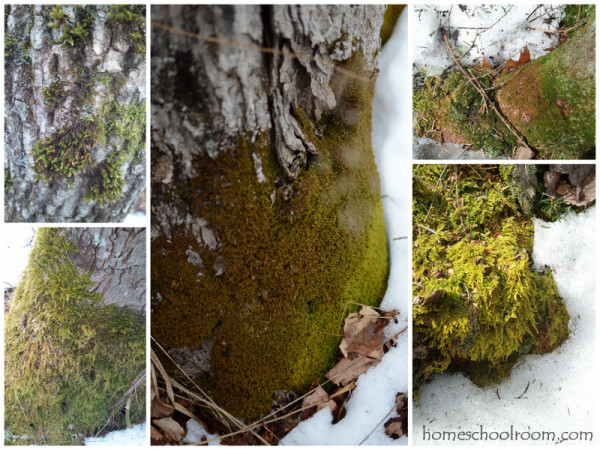
We were on the lookout for moss during several walks in the woods. One day it was finally warm enough that everything wasn’t frozen solid so I could break off some pieces of rotting trees for moss samples. I had been anxious to bring some home to put on the nature table like Barb did in her Moss Up Close post.
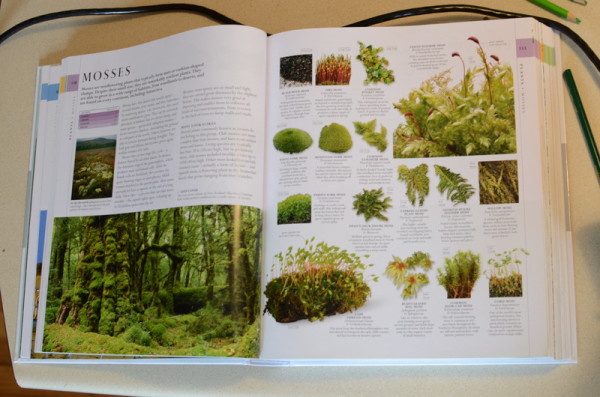
We read about moss in our Smithsonian Natural History book and then watched the animated video of moss life cycle from Barb’s 2008 Moss Nature Study post. The terminology and specifics in the video was too advanced for a 7 and 10 year old, but the animation gave them an overall idea of spores and their release from the capsules.
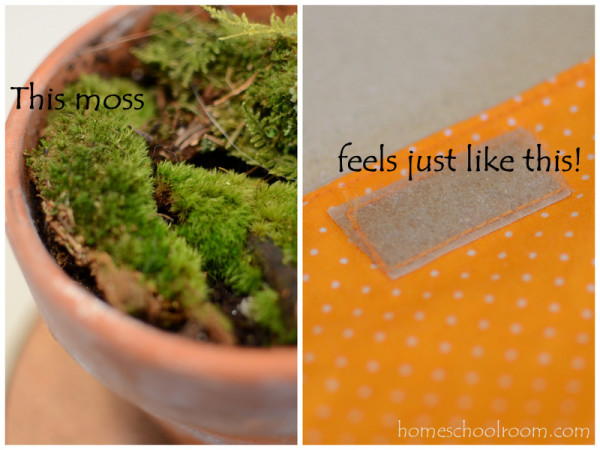
Feeling one of our moss samples reminded me of the feeling of a very familiar material–the soft side of velcro!
We examined our moss with magnifying lenses and a stereo microscope. Happily one of our samples had stalks and capsules! We also are fortunate to have a box of old slides from a high school–one of which was the cross section of a moss capsule. Everyone completed Barb’s free printable moss observation page.
Bracket Fungus Nature Study
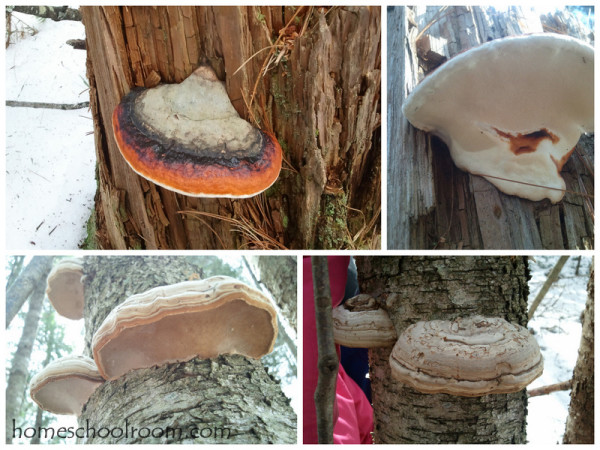
On another beautiful early spring day we headed to the woods on a bracket fungus hunt. After imagining the moss to be fairy forests my daughter decided that the bracket fungi were like fairy stadiums.
I shared with the kids the story from the Handbook of Nature Study of how a little spore enters through a break in the tree and grows deep into the tree, and how the bracket we see is really just like the flower–the real part of the plant is hidden in the poor tree, which is doomed to an early death. We were able to bring a few bracket fungi home to inspect. The magnifying lenses revealed the millions of tiny tubes opening onto the underside.
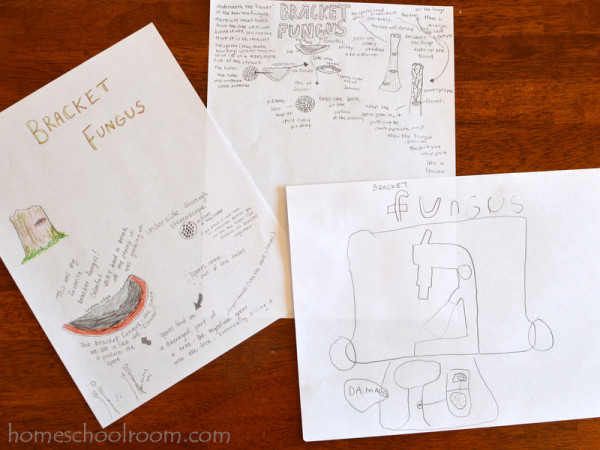
More nature journal pages! My daughter just loves it when I join in on nature journaling. I love seeing the differences in what interests each of us about our nature study subjects.
Mallard Nature Study
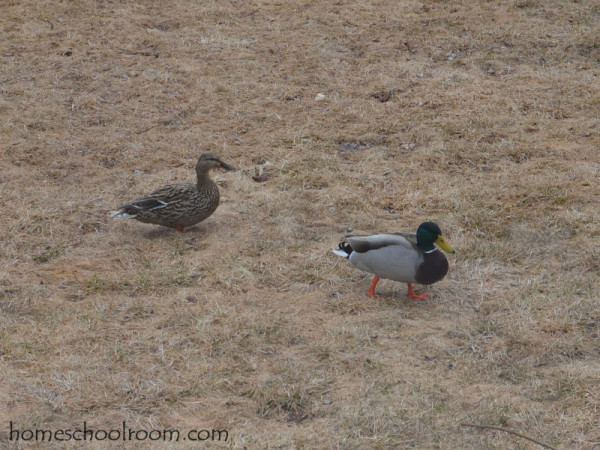
Our third nature study subject found us: Mallard ducks in our backyard! It’s very unusual, for though there is a marshy area in our neighborhood it does not border our property. The only other year we’ve seen a Mallard in our yard was several years ago during a very wet spring. We saw them three different days this week and an impromptu mallard study ensued.
I found bits and pieces of information in books we had. National Geographic Kids had some more details. Though Cornell’s site is my go-to reference for backyard birds it was the last place I checked for Mallard information. Duh. The All About Birds Mallard page was a wonderful resource with videos, audio clips and extensive information. The video of the adult duck “dabbling” for food (they don’t dive, just tip their heads in with hind end in the air) and the mating ritual (their heads bob in unison like a silly dance) had my kids in stitches.
Other happenings of the last two weeks:
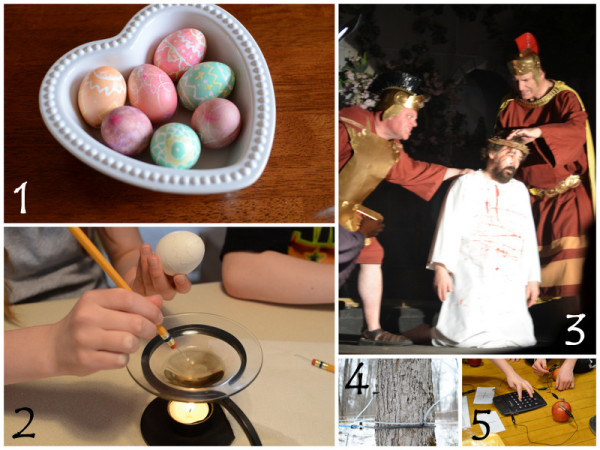
1 & 2: We tried a new egg dying technique this year after reading Rechenka’s Eggs. It was a modified version of Pysanky from our book Everything You Never Learned About Birds. It involved using the head of a pin to apply melted wax, and adding layers of dye and wax. Quite labor intensive, but very fun.
3: A beautiful Messiah play has become a yearly tradition that grounds us all in the midst of bunnies and candy eggs.
4: Another yearly tradition: a visit to a maple syrup producer for Maine Maple Sunday.
5: A science program called Garden Batteries had us powering lights and calculators with produce. This was very fun and I see more experiments in our future.
One last note: I must again express my gratitude for our homeschooling lifestyle. At a library event a few public schooled boys made some completely inappropriate comments to MY little girl. I was able to use the opportunity to have some frank discussions with my daughter. Oh, how glad I am to be present with her and have the relationship with her where she’ll tell me things. How glad I am that her education can take priority in her days, not the sad state of socialization in most schools.
Thank you to the wonderful hostesses with fun link-ups on Fridays. Be sure to join the fun and see what other homeschoolers are up to!
I’m Liking Lichen
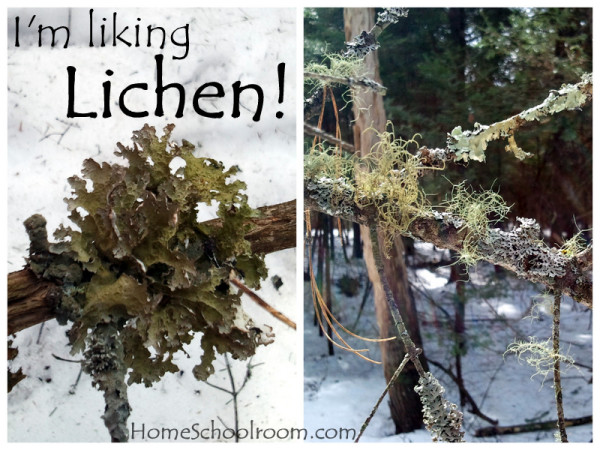
Pretty cheesy pun, I know, but I am suddenly appreciating lichen after years of never giving it a second look. Lichen is so prevalent that it seems ordinary, and I’m guilty of not taking the time to really observe it or point it out to my children. But, as with many things in nature, the more I pay attention the more fascinated I become! Participating in the Outdoor Hour Challenges with Barb from The Handbook of Nature Study blog encourages me to study topics in nature I may overlook.
Luckily even in Maine where the ground is still covered in snow like it is this March we can find lichen. We walked in the woods and were surprised at its diversity. I grabbed a couple branches from the ground with samples to bring home.
Since I had never paid much attention to lichen coming into this study I felt like Barb did in her post about moss and lichen back in 2008, when she said she had to do more research and observation for this study because she was so uneducated about it. The information on lichen in the Handbook of Nature Study book was uncharacteristically slim, but Barb’s newsletter had a very useful page on the three kinds of lichen that I printed and kept on our nature table.
I also found two helpful videos. The first video from Science Friday helped us understand what lichen is–actually three different organisms (fungi, algae and bacteria) coming together to make a composite organism that can survive in almost any environment.
{As an aside, I love their videos. Science Friday is a two hour radio show on NPR, but they also make short videos. All of the ones I’ve watched so far have been wonderful! They are concise, the narrator speaks clearly, and they always talk with an expert in the field–in this particular case a lichenologist. Check out Science Friday’s YouTube channel, I think you’ll love it!}
The second video is from Clemson University’s extension program, and it describes the different varieties of lichen and what lichen needs to grow.
After the videos we inspected our samples with magnifying glasses and a stereo microscope, making drawings for our nature journals.
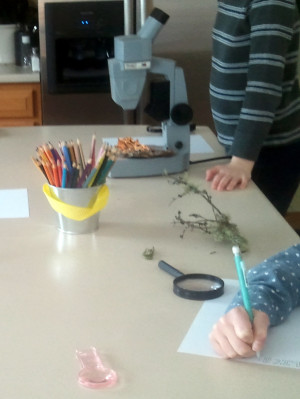
My son’s page cracked me up. He really enjoyed the Science Friday video and the cartoon they used to illustrate the different components of lichen (you can see the characters at the very bottom of his drawing).
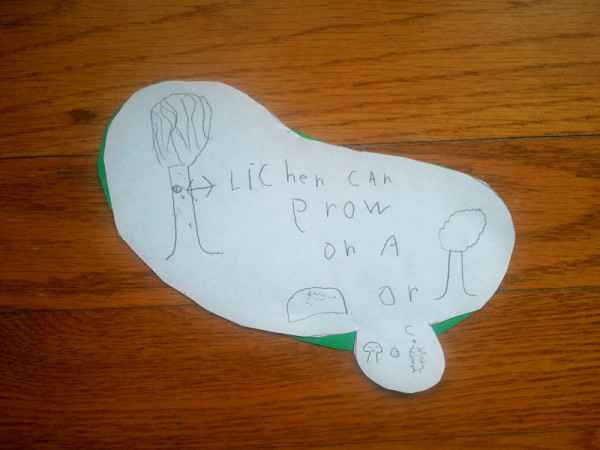
(Notice the question mark over the bacterium because they aren’t sure what it’s purpose is.) He also then took his drawing into another room to secretly cut it out and back it with green paper because “he knew I’d like that.” He knows his crafty mom likes it when he spends time making his work detailed.
We learned quite a bit, and I’m already noticing us paying a lot more attention to lichen when we’re out and about. Touring a sugar bush for Maine Maple Sunday found us also pointing out interesting lichen samples.
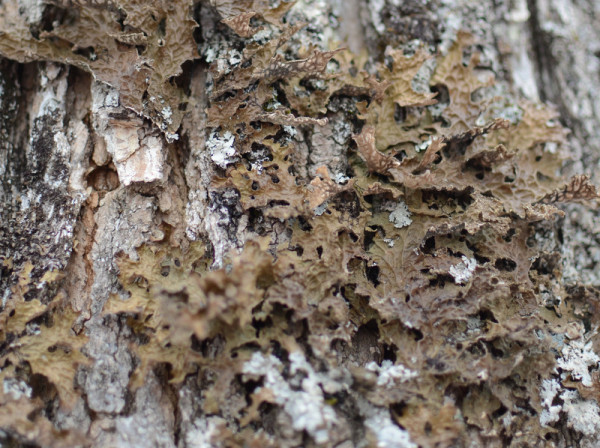
Next I hope to learn a bit about moss, since we can still find samples above the snow. I plan to copy Barb and bring moss in for our nature table, and I like her printable for moss observations.
Any one else working to keep nature study going in a long northern winter?




